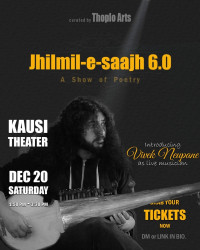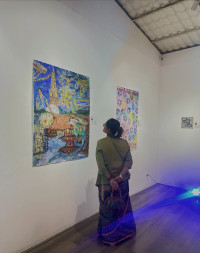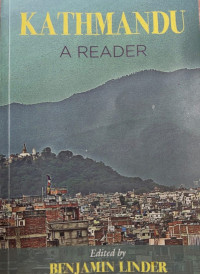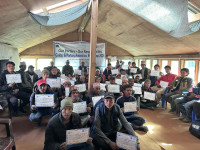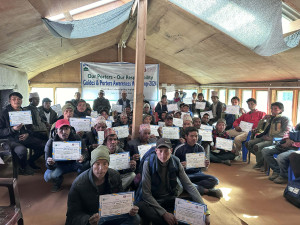Culture & Lifestyle
Tending to the deeper aesthetic of art
Japanese artists Izumi Tanabe and Hideo Iida express suppression and explore spatial concepts in abstract forms in the exhibition titled ‘Japan 4.’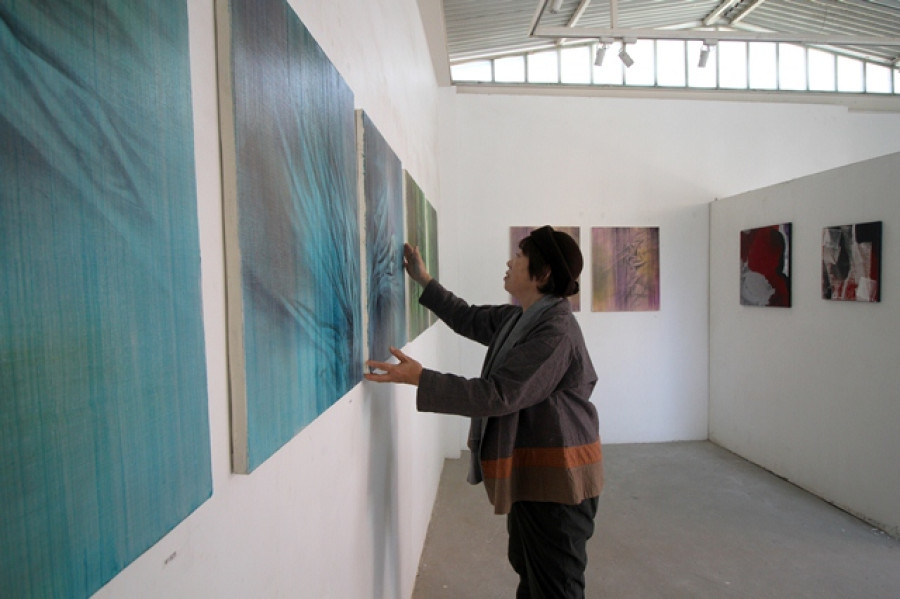
Srizu Bajracharya
How do you begin to understand art that is so obscure, especially when the creators of the art don’t speak the same language as you?
At Mcube Gallery, Izumi Tanabe and Hideo Iida, carefully unwrap their paintings they have brought with them from Japan. This is their second exhibition in Kathmandu, the first was held in 2018 at the Taragaon Museum. Izumi and Iida are two Japanese artists, one-half of the Japanese artist group ‘Japan 4’, who have been travelling around countries to show their contemporary creations. But their artworks are beyond ordinary comprehension.
And yet, their paintings are alluring in a mysterious way. When a spectator observes their artworks for a long time, the two artists stand beside them, as though to resolve their queries if they have any. And although they have difficulty explaining to people their concepts—with the obvious language barrier, the two seem to enjoy to talk about their art. Whenever a spectator points for meaning, they immediately try to find words on a translation app in their mobile phone to make the viewer understand their works. But quickly, there is a tinge of guilt that begins to spread on some of the examiners’ faces, for they understand—as the two artists go all out to utter sense to their works for the outsiders of art—that their art is purely personal and spiritual. And only those, who will understand this depth, will appreciate their craft more.
The Mcube Gallery in Chakupat is not huge in space, but quite extensive for Izumi and Iida’s collective exhibition. As light passes through the windows, in the hollow white space at Mcube, Izumi’s work titled ‘Hanabi’ (fireworks in Japanese) feels sacred. There are 12 paintings in total, in which she strives to paint the loss of women as they endeavour to do something on their own. Her series show crumpled bedsheets coated in forlorn acrylic colours—hues of blue, aquatic green and woeful purple.

Izumi explains in an art brief that her artworks represent the tenderness and fragility of women and at the same time, their rise from their despondent lives. She writes, “How difficult it could have been for those women to raise their face and their chest who were forced to work and were not allowed to claim.” Her series tries to paint this very essence of the despondent feeling when a woman is made to work for survival and not for happiness or liberation.
She also mentions that the freedom women have in this age is a result of the arduous journey achieved by the women before them.
Her artworks will feel more poignant with the revelation that Izumi had worked as a clerk for 40 years. Her paintings feel like an expression of restraint women experienced in the rigid patriarchal society of the past and the present. Her paintings on canvas seem so vulnerable that they feel fragile, seemingly breakable.
But on the contrary, the juxtaposition of Hideo’s work titled, ‘Concept of Space’ seems to tell of the freedom that men have always had, which allows them to describe spaces and explore them. Although it might not be intentional, the artworks from this series were displayed at the right side of the exhibition space from the entrance, which aptly describes right as the position of power in political philosophy.
Hideo’s work also uses darker shades, but in comparison to Izumi’s hues, they seem brighter. He dominantly uses primary colours in his paintings with extensive use of silver, black and white. At a glance, they look like wearing walls that render a gratifying aesthetic. They look raw with the rough texture, which Hideo manages to make by painting layers of acrylic paint with a squeegee.
Hideo’s paintings are based on the Japanese concept of, ‘Ma’, an interval or void between all things. It is an experiential place that a human can visualise for themselves. And thus Hideo tries to express the intervals that he believes we live within.
You could see it as how we tend to imagine our safe spaces with things another human can never picture. Something like how we suddenly see clouds as different animals, a projection of our inherently personal imagination and whim. Hideo possibly was imagining life inside an ordinary ray of light, which may seem insignificant at the first glance but carries myriad of life. The crowd of dust particles that float in between the spaces that are only visible when looked at during a certain time of day and in a distinct atmosphere can be the closest explanation of Hideo’s attempt.

Hideo had initially, started working on the concept of space during his college days. According to him, he was always curious about the invisible spaces that surrounded him. In his previous exhibition at Taragaon Museum last year, Hideo had visualised the space inside a conch shell. His paintings articulated the scope of sound that a conch shell makes. Following the same pursuit of searching for space in the existential intervals, Hideo even in this series, make spectators believe that artists have their own way of looking at things and follow their unique intuition.
For art lovers, both Hideo and Izumi’s work will feel spiritual. The concept, though ineffable, will make people feel something deep; however, that is if they allow the feeling to move them. For some, it will take quite a while to understand where these two artists come from and what exactly they are trying to express. It wouldn’t be wrong to say that sometimes not being able to contribute to the experience one sees in art, for not having that cultural background, can detach people of its experience. But if you give it time, abstract concepts in the art can open more doors in terms of personalised understanding of an artist’s vision.
But there surely are a couple of things Nepali artists can learn from Hideo and Izumi, and that is their willingness to engage with their patrons. They seem to have come prepared knowing that people who will come to look at their art will be curious and will want to know about their inspirations. And therefore, their art rather than making a statement gives people an experience to dwell in.
For those interested in understanding the aesthetics of arts and their meaning, the ongoing exhibition at Mcube Gallery will be a delightful experience.
‘Japan 4’ will be on display until November 24 at Mcube Gallery, Chakupat.




 9.12°C Kathmandu
9.12°C Kathmandu


